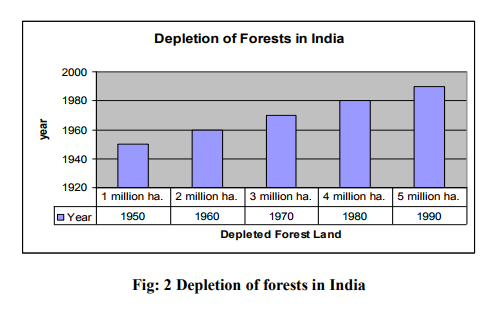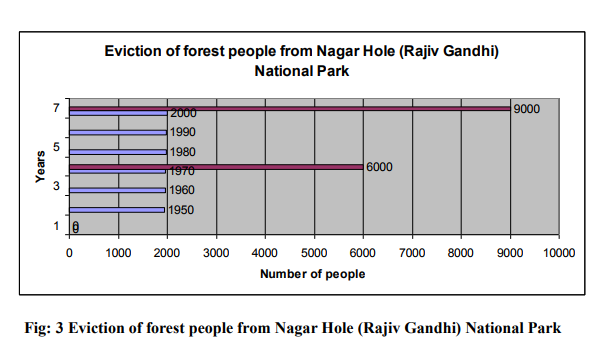IJCRR - 2(2), February, 2010
Pages: 16-23
Print Article
Download XML Download PDF
PRESENT SCENARIO OF INDIAN FORESTS AND THE LAWS WHICH SAVE THEM
Author: Aarti Bagdi
Category: General Sciences
Abstract:This study aims at highlighting the issues related to Indian forests and the forest dwellers. \"Making laws and implementing those laws\" by the country are two different things, but they are quite lacking in context of forests. Forests are the great source of economy to our country, but the rapid destruction is the subject to think on. Who is responsible and how it can be overcome? are the questions which really need an answer. So some emphasis should be led down to save them in terms of Eviction, Depletion and Deforestation. Figures and graphs mentioned in the article facilitate to compare the current situation with the past. Resultant of depleted forests like global warming, heavy soil erosion, extinction of species (eg. Only 1411 tigers are left) are the matters of concern. Our purpose is to motivate the common man if the policy makers are sleeping, to initiate and plant trees to \"save our planet\"
Full Text:
India is a developing Nation with the land area of total 328.7 million ha. of which 142.5 million ha. (43.3%) is under agriculture, Forests cover 76.5 million ha. (23.27%). According to the State of Forest Report (FSI 1997), the actual forest cover is 63.34 million ha (19.27%) of which 26.13 million ha. are degraded, (NFAP 1999). About 300 million tribal and other local people contribute to the “forest people” population of the country, and are the most disadvantaged section of society, subsist from forests. Government is running Programs and Acts to address to the issues and problems related to the “Forests” and “Forest people”. Do the forest recourses and a part of population of tribal people living in forests is safe under these Acts and Policies?

Government Forest Policy and Acts
Government of India under Ministry of Environment and forest, enunciated a policy called “National Forest Policy”, 1988. Its basic objectives are:- 1. To ensure environmental stability and maintenance of ecological balance. 2. To conserve the natural heritage of nation. 3. To Increase the productivity of the forests. 4. To check soil erosion. 5. To meet the requirement of fuel wood, fodder, minor forest produce and small timber of the rural and tribal populations. 6. To encourage reforestation to increase the forest cover. Secondly, we have National Forestry
Action Programme (NFAP) The National Forestry Action Programme is a comprehensive strategic long-term plan for the next 20 years to address the issues underlying major problems of the forestry sector in line with the National Forest Policy, 1988.Its objective is:- 1. To bring one-third area of the country under forest/tree cover. 2. To arrest deforestation for achieving sustainable development of forests. Thirdly, we have Indian Forest Act, 1927, The Indian Forest Act, 1927 was largely based on previous Indian Forest Acts implemented under the British. The first and most famous was the Indian Forest Act of 1878. It provides legal framework for management of forests in the country. In some States, the Act is applicable as it is, while some of the States have enacted their own which in essence, are the adopted versions of the Indian Forest Act 1927. Both the 1878 act and the 1927 one sought to consolidate and reserve the areas having forest cover, or significant wildlife, to regulate movement and transit of forest produce, and duty leviable on timber and other forest produce. It also defines the procedure to be followed for declaring an area to be a Reserved Forest, a Protected Forest or a Village Forest. It defines what is a forest offence, what are the acts prohibited inside a Reserved Forest, and penalties leviable on violation of the provisions of the Act.
Reasons behind the reduction of forests in India:-
1. The heavy pressure of population on land. Having about 2.5% of world's geographic area, India at present is supporting 16% of planet's human population and 18% of cattle population. The forest cover has been reducing both in quality and extent. 2. Lack of regeneration. 3. There are serious problems of encroachment, grazing, forest fire, shifting cultivation and illegal felling. Note: Between 1950 and 1980 India lost about 4.3 million ha. of forest land for non-forest use like growth of agriculture, heavy industries and other developmental process. A recent World Bank report estimated that due to degradation and deforestation the loss has been up to one million ha. per year during 1970s to 1980s.

Forest people:
The Adivasis, the original inhabitants of forests, most of the areas that now come under the Parks and the Protected Areas, appreciate the concern shown by the Congress towards the „needs of the people?. For e.g. “The Nagar Hole national park is now a part of the Nilgiris Biosphere Reserve -- one of the 440 biosphere reserves in 97 countries where the UNESCO is implementing the Man and Biosphere program. Nilgiris was the first internationally designated biosphere reserve in India. Several ethnic groups had inhabited the area from time immemorial. In 2000 there were 11,60,200 permanent inhabitants within the biosphere reserve subsisting on the use of natural resources such as medicinal plants, agriculture and agrihorticulture.” Over 9,000 indigenous people were residing in 58 hamlets, apart from those who lived within the forests, there were more than 23,000 adivasis residing within 5 km distance, all depending on the Nagar Hole forests for their survival called the National Park. Under the UN scheme for the Biosphere Reserve, the forests, the animals, the birds, the agriculture and the human being ought to have been protected for their uniqueness. But the government agencies continued to violate this norm for lucrative business interests. The natural forests were extensively logged and substituted with plantations of teak, eucalyptus and rosewood. Nearly 15 per cent of the area within the National Park is now under plantations. the government agencies continued to violate this norm for lucrative business interests. The natural forests were extensively logged and substituted with plantations of teak, eucalyptus and rosewood. Nearly 15 per cent of the area within the National Park is now under plantations.
Evictions: Governments have been systematically pushing out the adivasis to the forest fringes. In 1970s, a total of 1220 families consisting of more than 6000 people were pushed out to locations 1-12 km from their original habitats

To help these people who reside in forest areas through out the country, the FPP is under play.
The Forest Peoples Programme (FPP)
It is a non-governmental organisation, founded in 1990 that aims at: > campaigning for the rights of indigenous forest people. > bridges the gap between policy makers and forest people.
> Advocacy, practical projects and capacity building . Forest Peoples Programme (FPP) advocates an alternative vision of how forests should be managed and controlled, based on respect for the rights of the peoples who know them best. FPP works with forest peoples in South America, Central Africa, South and South East Asia, and Central Siberia to help these communities secure their rights, build up their own organisations and negotiate with governments and companies as to how economic development and conservation is best achieved on their lands
Suggestions: How to save forests?
1. Use less paper and avoid its misuse. 2. Aware the people about the harmful effects of depletion of forests eg. Global warming, pollution, extinction of species etc. 3. Planting trees on land where forests have been cut down. 4. Use mobile and save paper (IDEA plan for saving paper). 5. Public propaganda should be there regarding the long term advantages of forests. 6. Forest fires should be prevented. 7. Recycle paper usage should be promoted. 8. Act as a volunteer, participate in environmental issues and programs and save the “mute living trees”. 9. Everyone should plant more and more trees.
Recent news and Amendments: 1. Tamil Nadu to implement National Forest Policy: to
increase the forest cover area in the country to 33 per cent through the multi-pronged approach of Tamil Nadu Afforestation Project. 2. Goa has its own Forest Policy: This state policy will take care of Forests, Forest dwellers, everything in totality. Policy3. NGO for medicinal plants under Forest : Omkar Mission Research Institute is demanding plantation of medicinal plants under target set by Central Govt. to reach 33% forest cover by 2012 following NFP, 1988.
Revision of NFP,1988 due to 73 and 74th constitutional amendment:
The 29 functions recommend for the decentralization to the Panchayat Raj Institutions listed in the 11th schedule include "Agricultures, Land reforms, Land improvement and management, Minor irrigations, Water management, Watershed development, Animal husbandry, Fisheries, Social and Farm forestry, Non - Timber Forest Produces (NTFPs) and maintenance of community assets, Management of state owned forestlands is not included but may be specifically notified by individual State Governments. Indian Forest Act: The 42nd Constitutional Amendment shifts forests from the “State List” to the “Concurrent List”. The FCA prohibits non-forest use of forest land without the government?s approval. It also advocates “sustainable forest management through participatory approach”, with “due regard to the traditional rights of the tribal people on forest land”.
Forest- related provisions in the Constitution of India: according to 48A the “state shall endeavor to protect and improve the environment and safeguard the forest and wildlife of the country”. Article 51A of constitution include fundamental duty of every citizen to protect and improve the natural environment involving forests, lakes, wildlife, rivers, living creatures.
Conclusion:
All the facts, policies, programs and figures mentioned here are reflecting the current situation of forests and the part of population living their in forests. It is a matter of great concern that forests should be preserved and the eviction of the poor people should be abolished to avoid the upcoming harm to the forests. “It?s not important that how many people are motivated, but it is important that how many implement that motivation in their life.” Besides that, our ministers should also think in the direction more seriously and come up with an “accurate fruitful solution”.
References:
1. “Who drove the policy, changes in forestry sector in India” by Ms Sumana Datta, accessed on 20th Jan 2010.
2. “Indian Forest Act, 1927, National Forest Policy (NFP) 1988, National Forestry Action Programme. (NFAP)”, accessed on 23rd Jan 2010.
3. “Save Forests and Wildlife” Naira Yaqoob, accessed on 30th Jan 2010.
4. “The National Forestry Action Programme”,
5. National Forest Policy ReviewIndia by Indian Institute of Forest Management accessed on 2nd March 2010
6. “Assam Forest Policy 2004” www.envisassam.nic.in/forestpolicy.asp, accessed on 3rd March 2010.
7. The Times of India, Flora and Fauna, Oct?2009, accessed on 3 rd March 2010.
8. THE HINDU, Feb?2008. accessed on 5th March 2010.
9. Expressindia, R. Raghavan, Sep?2007, accessed on 5th March 2010.
|






 This work is licensed under a Creative Commons Attribution-NonCommercial 4.0 International License
This work is licensed under a Creative Commons Attribution-NonCommercial 4.0 International License